University Finance Project: GOGreen Motors Investment Analysis
VerifiedAdded on 2022/10/10
|11
|829
|126
Project
AI Summary
This finance project analyzes a capital budgeting scenario for GOGreen Motors, an electric vehicle manufacturer. The project assesses the financial viability of an investment using various metrics, including payback period, net present value (NPV), and profitability index. Part A calculates and interprets...

Running head: ACCOUNTING AND FINANCE
Accounting and Finance
Name of the Student:
Name of the University:
Author’s Note:
Accounting and Finance
Name of the Student:
Name of the University:
Author’s Note:
Paraphrase This Document
Need a fresh take? Get an instant paraphrase of this document with our AI Paraphraser
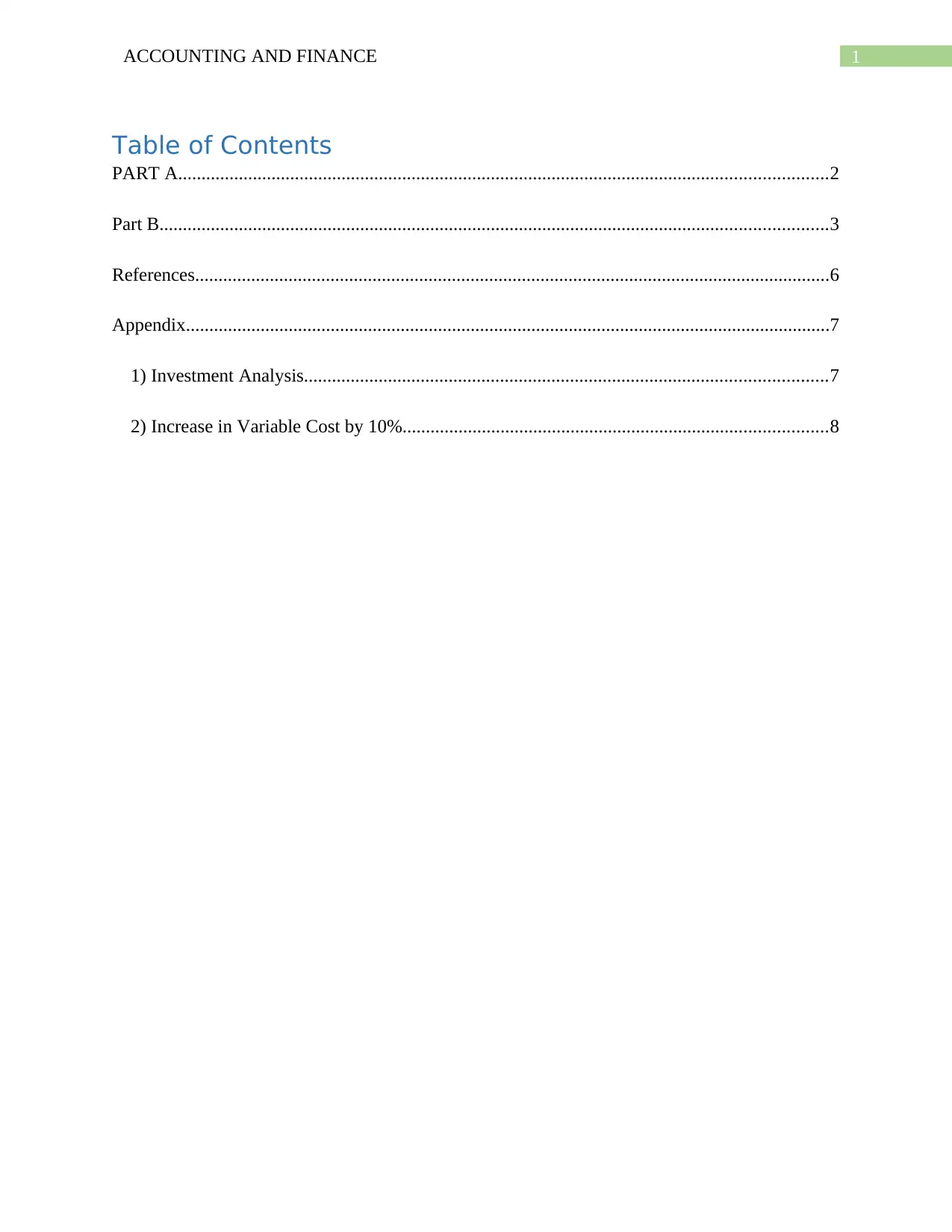
1ACCOUNTING AND FINANCE
Table of Contents
PART A...........................................................................................................................................2
Part B...............................................................................................................................................3
References........................................................................................................................................6
Appendix..........................................................................................................................................7
1) Investment Analysis................................................................................................................7
2) Increase in Variable Cost by 10%...........................................................................................8
Table of Contents
PART A...........................................................................................................................................2
Part B...............................................................................................................................................3
References........................................................................................................................................6
Appendix..........................................................................................................................................7
1) Investment Analysis................................................................................................................7
2) Increase in Variable Cost by 10%...........................................................................................8
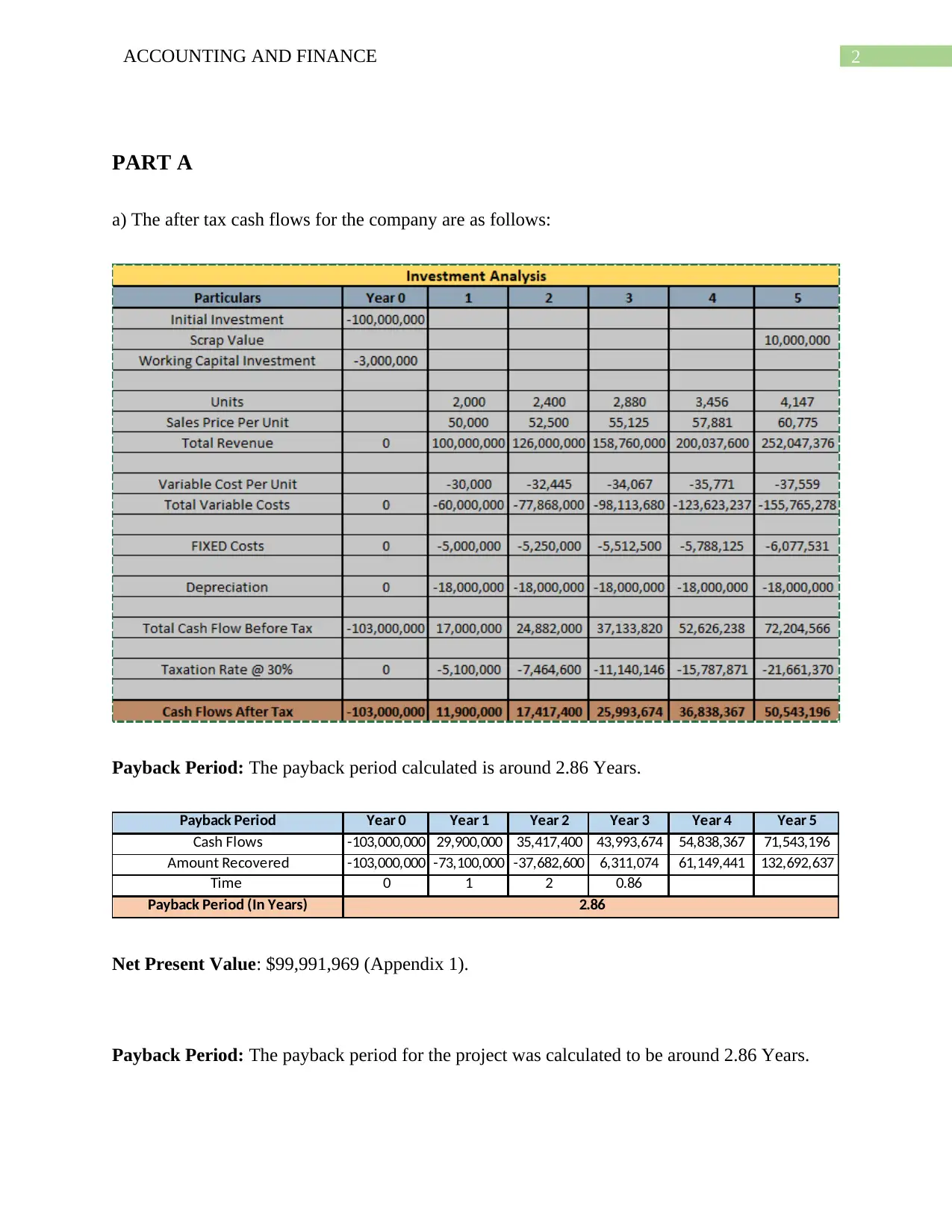
2ACCOUNTING AND FINANCE
PART A
a) The after tax cash flows for the company are as follows:
Payback Period: The payback period calculated is around 2.86 Years.
Payback Period Year 0 Year 1 Year 2 Year 3 Year 4 Year 5
Cash Flows -103,000,000 29,900,000 35,417,400 43,993,674 54,838,367 71,543,196
Amount Recovered -103,000,000 -73,100,000 -37,682,600 6,311,074 61,149,441 132,692,637
Time 0 1 2 0.86
Payback Period (In Years) 2.86
Net Present Value: $99,991,969 (Appendix 1).
Payback Period: The payback period for the project was calculated to be around 2.86 Years.
PART A
a) The after tax cash flows for the company are as follows:
Payback Period: The payback period calculated is around 2.86 Years.
Payback Period Year 0 Year 1 Year 2 Year 3 Year 4 Year 5
Cash Flows -103,000,000 29,900,000 35,417,400 43,993,674 54,838,367 71,543,196
Amount Recovered -103,000,000 -73,100,000 -37,682,600 6,311,074 61,149,441 132,692,637
Time 0 1 2 0.86
Payback Period (In Years) 2.86
Net Present Value: $99,991,969 (Appendix 1).
Payback Period: The payback period for the project was calculated to be around 2.86 Years.
You're viewing a preview
Unlock full access by subscribing today!
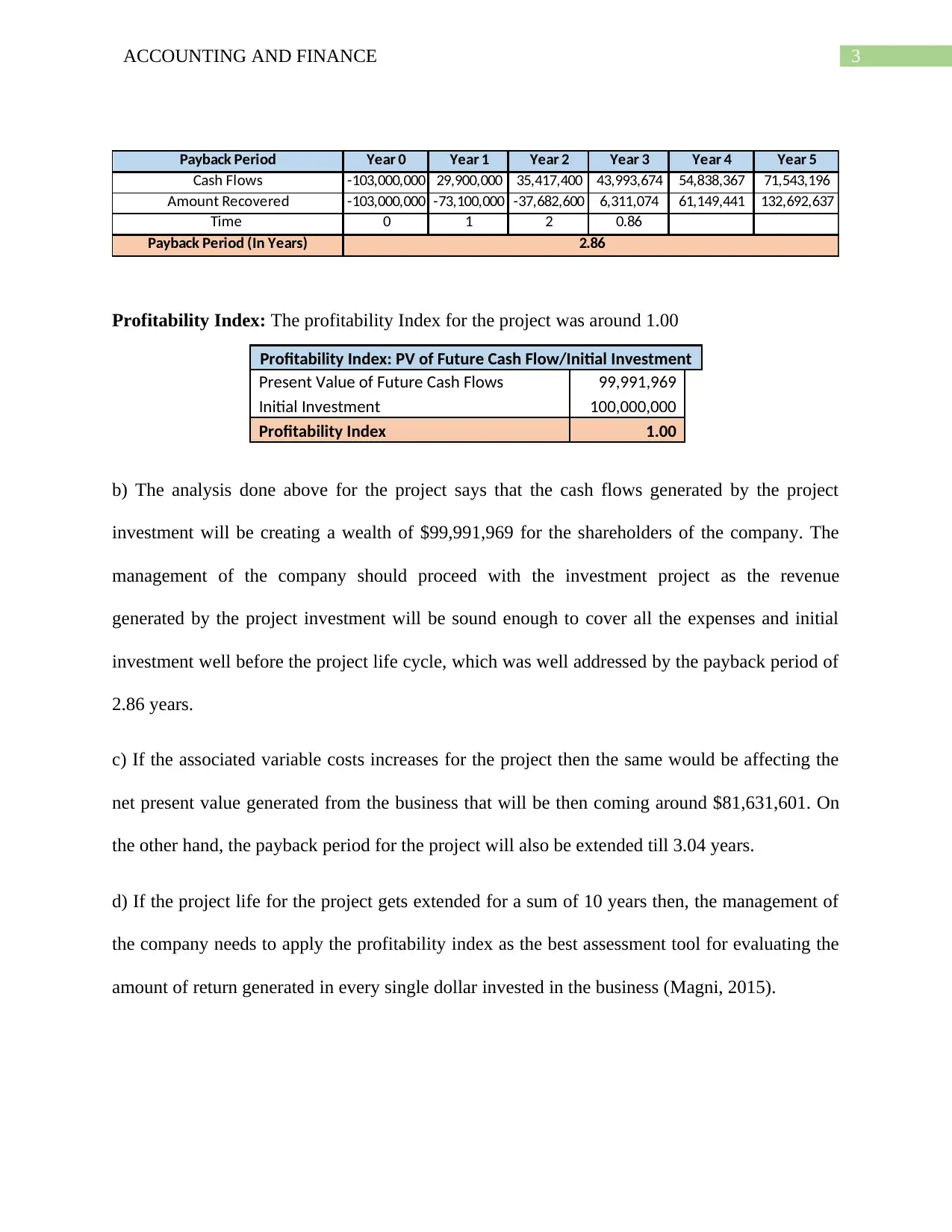
3ACCOUNTING AND FINANCE
Profitability Index: The profitability Index for the project was around 1.00
Profitability Index: PV of Future Cash Flow/Initial Investment
Present Value of Future Cash Flows 99,991,969
Initial Investment 100,000,000
Profitability Index 1.00
b) The analysis done above for the project says that the cash flows generated by the project
investment will be creating a wealth of $99,991,969 for the shareholders of the company. The
management of the company should proceed with the investment project as the revenue
generated by the project investment will be sound enough to cover all the expenses and initial
investment well before the project life cycle, which was well addressed by the payback period of
2.86 years.
c) If the associated variable costs increases for the project then the same would be affecting the
net present value generated from the business that will be then coming around $81,631,601. On
the other hand, the payback period for the project will also be extended till 3.04 years.
d) If the project life for the project gets extended for a sum of 10 years then, the management of
the company needs to apply the profitability index as the best assessment tool for evaluating the
amount of return generated in every single dollar invested in the business (Magni, 2015).
Payback Period Year 0 Year 1 Year 2 Year 3 Year 4 Year 5
Cash Flows -103,000,000 29,900,000 35,417,400 43,993,674 54,838,367 71,543,196
Amount Recovered -103,000,000 -73,100,000 -37,682,600 6,311,074 61,149,441 132,692,637
Time 0 1 2 0.86
Payback Period (In Years) 2.86
Profitability Index: The profitability Index for the project was around 1.00
Profitability Index: PV of Future Cash Flow/Initial Investment
Present Value of Future Cash Flows 99,991,969
Initial Investment 100,000,000
Profitability Index 1.00
b) The analysis done above for the project says that the cash flows generated by the project
investment will be creating a wealth of $99,991,969 for the shareholders of the company. The
management of the company should proceed with the investment project as the revenue
generated by the project investment will be sound enough to cover all the expenses and initial
investment well before the project life cycle, which was well addressed by the payback period of
2.86 years.
c) If the associated variable costs increases for the project then the same would be affecting the
net present value generated from the business that will be then coming around $81,631,601. On
the other hand, the payback period for the project will also be extended till 3.04 years.
d) If the project life for the project gets extended for a sum of 10 years then, the management of
the company needs to apply the profitability index as the best assessment tool for evaluating the
amount of return generated in every single dollar invested in the business (Magni, 2015).
Payback Period Year 0 Year 1 Year 2 Year 3 Year 4 Year 5
Cash Flows -103,000,000 29,900,000 35,417,400 43,993,674 54,838,367 71,543,196
Amount Recovered -103,000,000 -73,100,000 -37,682,600 6,311,074 61,149,441 132,692,637
Time 0 1 2 0.86
Payback Period (In Years) 2.86
Paraphrase This Document
Need a fresh take? Get an instant paraphrase of this document with our AI Paraphraser
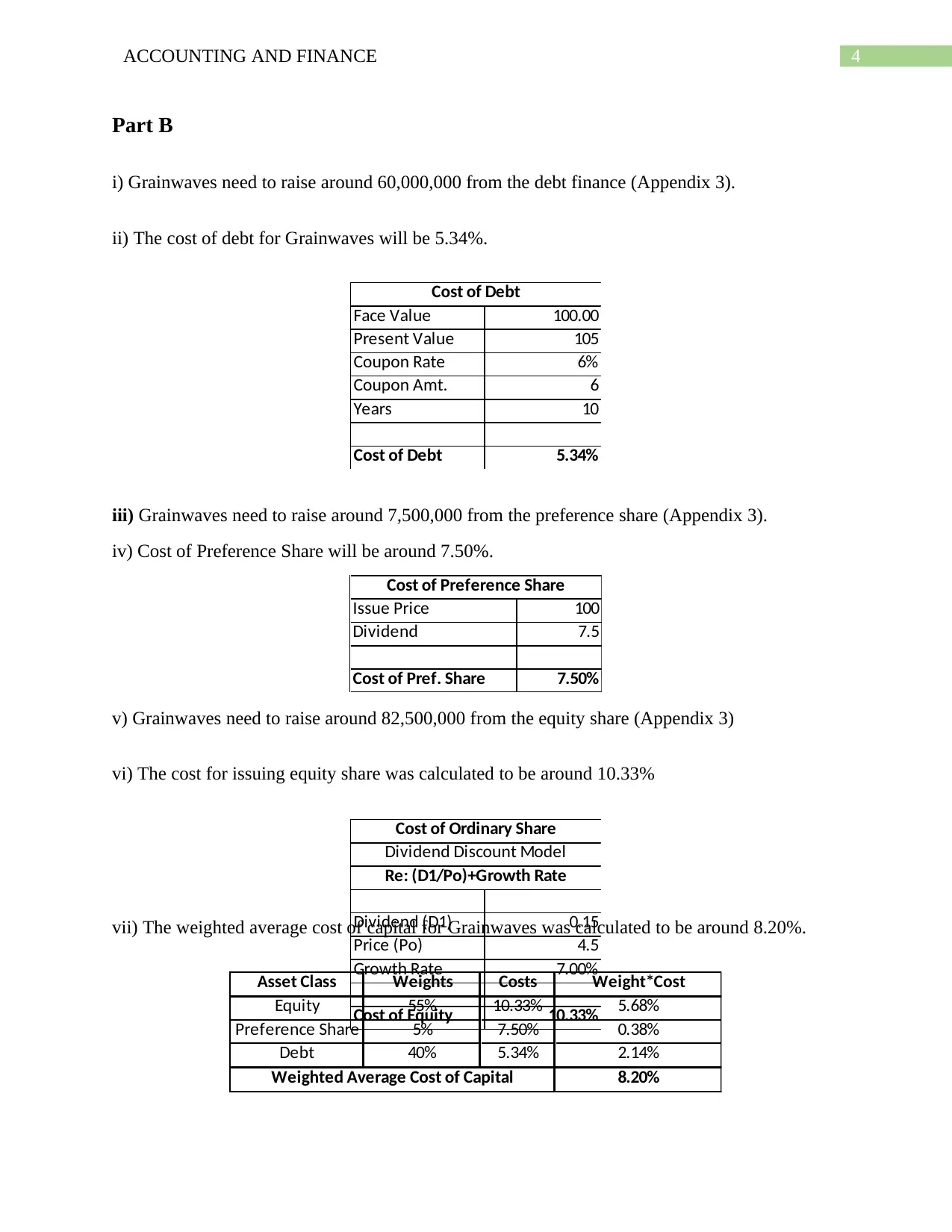
4ACCOUNTING AND FINANCE
Part B
i) Grainwaves need to raise around 60,000,000 from the debt finance (Appendix 3).
ii) The cost of debt for Grainwaves will be 5.34%.
Face Value 100.00
Present Value 105
Coupon Rate 6%
Coupon Amt. 6
Years 10
Cost of Debt 5.34%
Cost of Debt
iii) Grainwaves need to raise around 7,500,000 from the preference share (Appendix 3).
iv) Cost of Preference Share will be around 7.50%.
Issue Price 100
Dividend 7.5
Cost of Pref. Share 7.50%
Cost of Preference Share
v) Grainwaves need to raise around 82,500,000 from the equity share (Appendix 3)
vi) The cost for issuing equity share was calculated to be around 10.33%
vii) The weighted average cost of capital for Grainwaves was calculated to be around 8.20%.
Asset Class Weights Costs Weight*Cost
Equity 55% 10.33% 5.68%
Preference Share 5% 7.50% 0.38%
Debt 40% 5.34% 2.14%
8.20%Weighted Average Cost of Capital
Dividend (D1) 0.15
Price (Po) 4.5
Growth Rate 7.00%
Cost of Equity 10.33%
Cost of Ordinary Share
Dividend Discount Model
Re: (D1/Po)+Growth Rate
Part B
i) Grainwaves need to raise around 60,000,000 from the debt finance (Appendix 3).
ii) The cost of debt for Grainwaves will be 5.34%.
Face Value 100.00
Present Value 105
Coupon Rate 6%
Coupon Amt. 6
Years 10
Cost of Debt 5.34%
Cost of Debt
iii) Grainwaves need to raise around 7,500,000 from the preference share (Appendix 3).
iv) Cost of Preference Share will be around 7.50%.
Issue Price 100
Dividend 7.5
Cost of Pref. Share 7.50%
Cost of Preference Share
v) Grainwaves need to raise around 82,500,000 from the equity share (Appendix 3)
vi) The cost for issuing equity share was calculated to be around 10.33%
vii) The weighted average cost of capital for Grainwaves was calculated to be around 8.20%.
Asset Class Weights Costs Weight*Cost
Equity 55% 10.33% 5.68%
Preference Share 5% 7.50% 0.38%
Debt 40% 5.34% 2.14%
8.20%Weighted Average Cost of Capital
Dividend (D1) 0.15
Price (Po) 4.5
Growth Rate 7.00%
Cost of Equity 10.33%
Cost of Ordinary Share
Dividend Discount Model
Re: (D1/Po)+Growth Rate
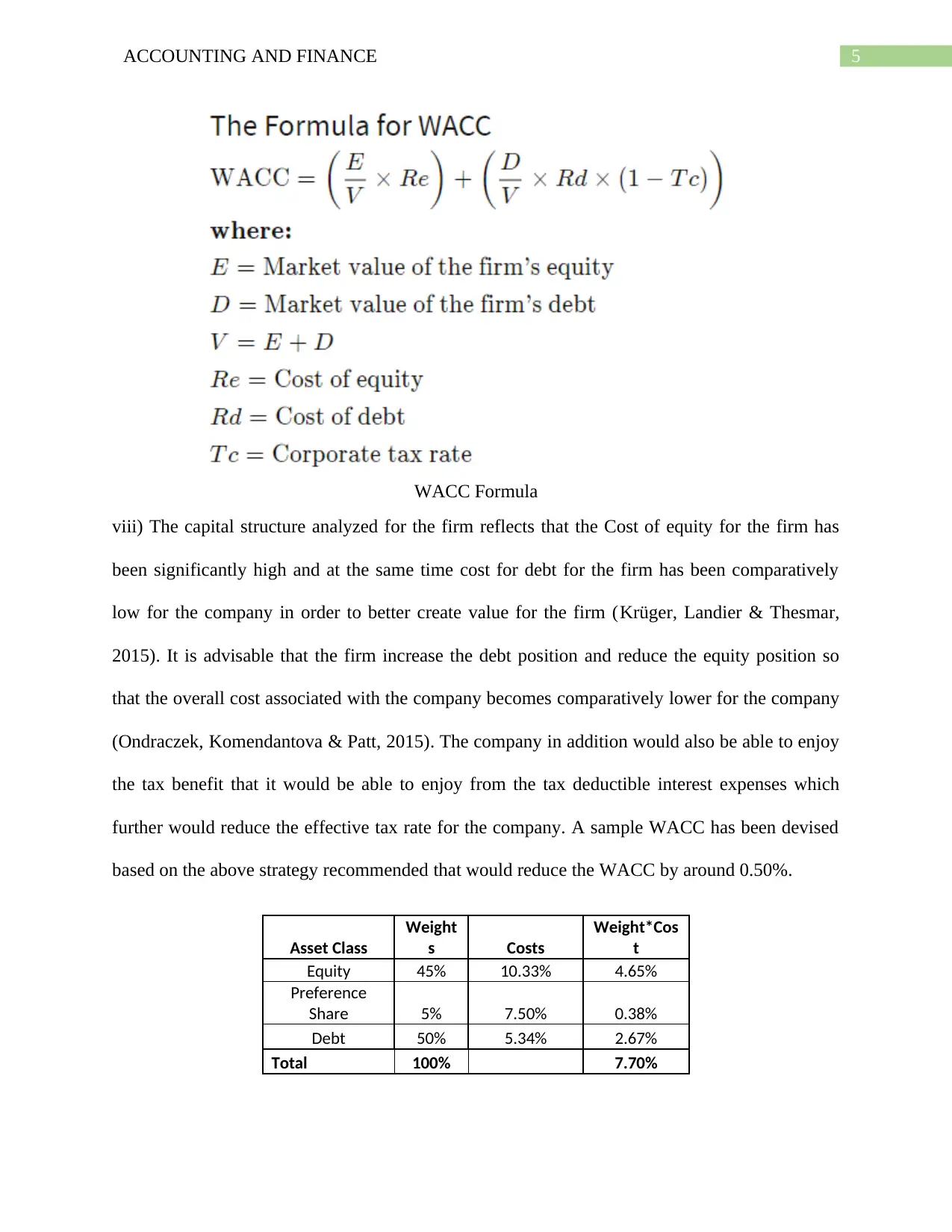
5ACCOUNTING AND FINANCE
WACC Formula
viii) The capital structure analyzed for the firm reflects that the Cost of equity for the firm has
been significantly high and at the same time cost for debt for the firm has been comparatively
low for the company in order to better create value for the firm (Krüger, Landier & Thesmar,
2015). It is advisable that the firm increase the debt position and reduce the equity position so
that the overall cost associated with the company becomes comparatively lower for the company
(Ondraczek, Komendantova & Patt, 2015). The company in addition would also be able to enjoy
the tax benefit that it would be able to enjoy from the tax deductible interest expenses which
further would reduce the effective tax rate for the company. A sample WACC has been devised
based on the above strategy recommended that would reduce the WACC by around 0.50%.
Asset Class
Weight
s Costs
Weight*Cos
t
Equity 45% 10.33% 4.65%
Preference
Share 5% 7.50% 0.38%
Debt 50% 5.34% 2.67%
Total 100% 7.70%
WACC Formula
viii) The capital structure analyzed for the firm reflects that the Cost of equity for the firm has
been significantly high and at the same time cost for debt for the firm has been comparatively
low for the company in order to better create value for the firm (Krüger, Landier & Thesmar,
2015). It is advisable that the firm increase the debt position and reduce the equity position so
that the overall cost associated with the company becomes comparatively lower for the company
(Ondraczek, Komendantova & Patt, 2015). The company in addition would also be able to enjoy
the tax benefit that it would be able to enjoy from the tax deductible interest expenses which
further would reduce the effective tax rate for the company. A sample WACC has been devised
based on the above strategy recommended that would reduce the WACC by around 0.50%.
Asset Class
Weight
s Costs
Weight*Cos
t
Equity 45% 10.33% 4.65%
Preference
Share 5% 7.50% 0.38%
Debt 50% 5.34% 2.67%
Total 100% 7.70%
You're viewing a preview
Unlock full access by subscribing today!
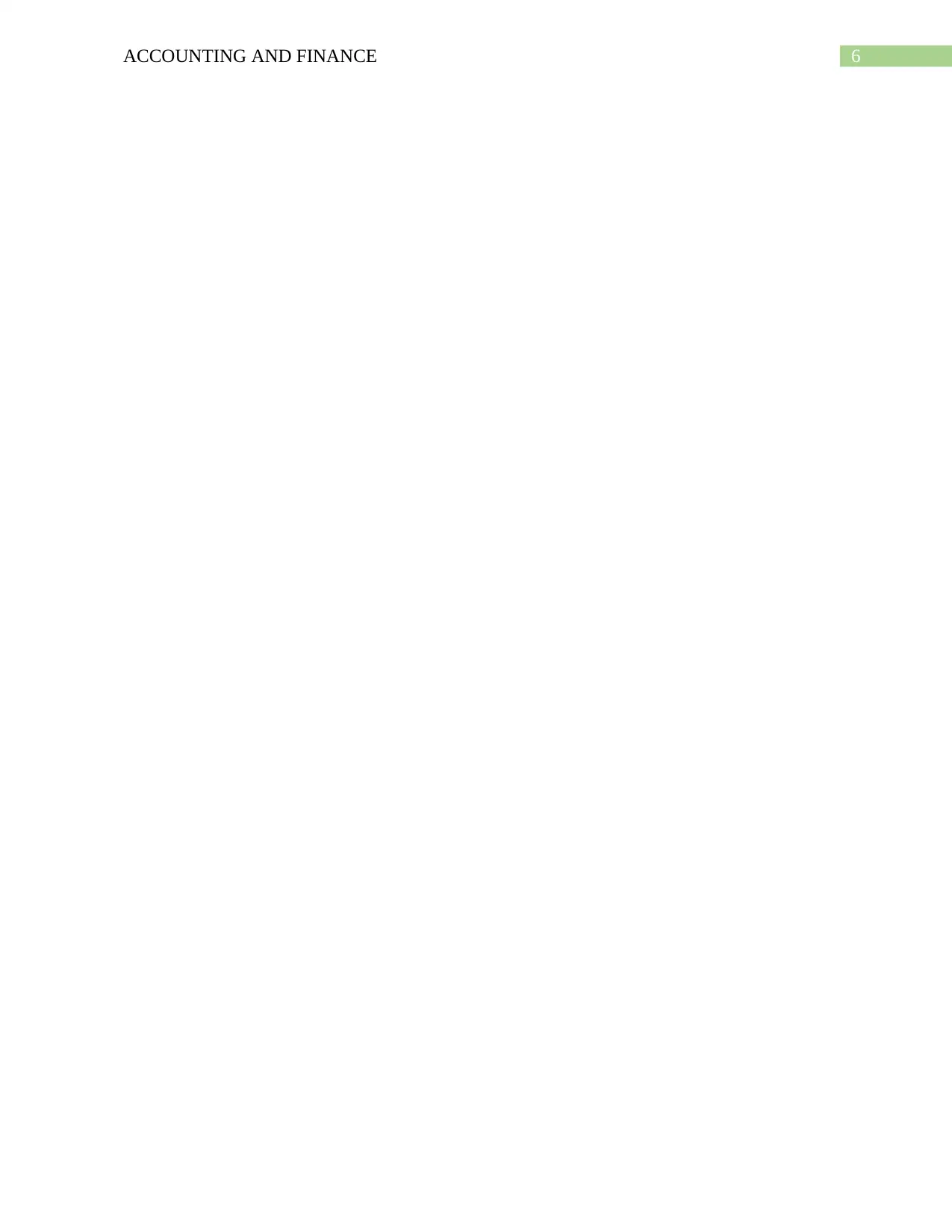
6ACCOUNTING AND FINANCE
Paraphrase This Document
Need a fresh take? Get an instant paraphrase of this document with our AI Paraphraser

7ACCOUNTING AND FINANCE
References
Krüger, P., Landier, A., & Thesmar, D. (2015). The WACC fallacy: The real effects of using a
unique discount rate. The Journal of Finance, 70(3), 1253-1285.
Mari, C., & Marra, M. (2019). Valuing firm’s financial flexibility under default risk and
bankruptcy costs: a WACC based approach. International Journal of Managerial
Finance.
Magni, C. A. (2015). Investment, financing and the role of ROA and WACC in value
creation. European Journal of Operational Research, 244(3), 855-866.
Ondraczek, J., Komendantova, N., & Patt, A. (2015). WACC the dog: The effect of financing
costs on the levelized cost of solar PV power. Renewable Energy, 75, 888-898.
.
References
Krüger, P., Landier, A., & Thesmar, D. (2015). The WACC fallacy: The real effects of using a
unique discount rate. The Journal of Finance, 70(3), 1253-1285.
Mari, C., & Marra, M. (2019). Valuing firm’s financial flexibility under default risk and
bankruptcy costs: a WACC based approach. International Journal of Managerial
Finance.
Magni, C. A. (2015). Investment, financing and the role of ROA and WACC in value
creation. European Journal of Operational Research, 244(3), 855-866.
Ondraczek, J., Komendantova, N., & Patt, A. (2015). WACC the dog: The effect of financing
costs on the levelized cost of solar PV power. Renewable Energy, 75, 888-898.
.

8ACCOUNTING AND FINANCE
Appendix
1) Investment Analysis
Particulars Year 0 1 2 3 4 5
Initial Investment -100,000,000
Scrap Value 10,000,000
Working Capital Investment -3,000,000
Units 2,000 2,400 2,880 3,456 4,147
Sales Price Per Unit 50,000 52,500 55,125 57,881 60,775
Total Revenue 0 100,000,000 126,000,000 158,760,000 200,037,600 252,047,376
Variable Cost Per Unit -30,000 -32,445 -34,067 -35,771 -37,559
Total Variable Costs 0 -60,000,000 -77,868,000 -98,113,680 -123,623,237 -155,765,278
FIXED Costs 0 -5,000,000 -5,250,000 -5,512,500 -5,788,125 -6,077,531
Depreciation 0 -18,000,000 -18,000,000 -18,000,000 -18,000,000 -18,000,000
Total Cash Flow Before Tax -103,000,000 17,000,000 24,882,000 37,133,820 52,626,238 72,204,566
Taxation Rate @ 30% 0 -5,100,000 -7,464,600 -11,140,146 -15,787,871 -21,661,370
Cash Flows After Tax -103,000,000 11,900,000 17,417,400 25,993,674 36,838,367 50,543,196
Add: Non Cash Exp (Depreciation) 0 18,000,000 18,000,000 18,000,000 18,000,000 18,000,000
Add: Working Capital Recovery 0 0 0 0 0 3,000,000
Net Cash Flows -103,000,000 29,900,000 35,417,400 43,993,674 54,838,367 71,543,196
Discount Factor 1.00 0.96 0.92 0.88 0.84 0.80
Discounted Cash Flows -103,000,000 28,612,440 32,432,774 38,551,507 45,985,334 57,409,913
Net Present Value 99,991,969
Investment Analysis
Appendix
1) Investment Analysis
Particulars Year 0 1 2 3 4 5
Initial Investment -100,000,000
Scrap Value 10,000,000
Working Capital Investment -3,000,000
Units 2,000 2,400 2,880 3,456 4,147
Sales Price Per Unit 50,000 52,500 55,125 57,881 60,775
Total Revenue 0 100,000,000 126,000,000 158,760,000 200,037,600 252,047,376
Variable Cost Per Unit -30,000 -32,445 -34,067 -35,771 -37,559
Total Variable Costs 0 -60,000,000 -77,868,000 -98,113,680 -123,623,237 -155,765,278
FIXED Costs 0 -5,000,000 -5,250,000 -5,512,500 -5,788,125 -6,077,531
Depreciation 0 -18,000,000 -18,000,000 -18,000,000 -18,000,000 -18,000,000
Total Cash Flow Before Tax -103,000,000 17,000,000 24,882,000 37,133,820 52,626,238 72,204,566
Taxation Rate @ 30% 0 -5,100,000 -7,464,600 -11,140,146 -15,787,871 -21,661,370
Cash Flows After Tax -103,000,000 11,900,000 17,417,400 25,993,674 36,838,367 50,543,196
Add: Non Cash Exp (Depreciation) 0 18,000,000 18,000,000 18,000,000 18,000,000 18,000,000
Add: Working Capital Recovery 0 0 0 0 0 3,000,000
Net Cash Flows -103,000,000 29,900,000 35,417,400 43,993,674 54,838,367 71,543,196
Discount Factor 1.00 0.96 0.92 0.88 0.84 0.80
Discounted Cash Flows -103,000,000 28,612,440 32,432,774 38,551,507 45,985,334 57,409,913
Net Present Value 99,991,969
Investment Analysis
You're viewing a preview
Unlock full access by subscribing today!

9ACCOUNTING AND FINANCE
2) Increase in Variable Cost by 10%
Particulars Year 0 1 2 3 4 5
Initial Investment -100,000,000
Scrap Value 10,000,000
Working Capital Investment -3,000,000
Units 2,000 2,400 2,880 3,456 4,147
Sales Price Per Unit 50,000 52,500 55,125 57,881 60,775
Total Revenue 0 100,000,000 126,000,000 158,760,000 200,037,600 252,047,376
Variable Cost Per Unit -30,000 -34,650 -36,383 -38,202 -40,112
Total Variable Costs 0 -60,000,000 -83,160,000 -104,781,600 -132,024,816 -166,351,268
FIXED Costs 0 -5,000,000 -5,250,000 -5,512,500 -5,788,125 -6,077,531
Depreciation 0 -18,000,000 -18,000,000 -18,000,000 -18,000,000 -18,000,000
Total Cash Flow Before Tax -103,000,000 17,000,000 19,590,000 30,465,900 44,224,659 61,618,577
Taxation Rate @ 30% 0 -5,100,000 -5,877,000 -9,139,770 -13,267,398 -18,485,573
Cash Flows After Tax -103,000,000 11,900,000 13,713,000 21,326,130 30,957,261 43,133,004
Add: Non Cash Exp (Depreciation) 0 18,000,000 18,000,000 18,000,000 18,000,000 18,000,000
Add: Working Capital Recovery 0 0 0 0 0 3,000,000
Net Cash Flows -103,000,000 29,900,000 31,713,000 39,326,130 48,957,261 64,133,004
Discount Factor 1.00 0.96 0.92 0.88 0.84 0.80
Discounted Cash Flows -103,000,000 28,612,440 29,040,544 34,461,354 41,053,667 51,463,596
Net Present Value
Investment Analysis (Increase in Variable Cost by 10%)
81,631,601
2) Increase in Variable Cost by 10%
Particulars Year 0 1 2 3 4 5
Initial Investment -100,000,000
Scrap Value 10,000,000
Working Capital Investment -3,000,000
Units 2,000 2,400 2,880 3,456 4,147
Sales Price Per Unit 50,000 52,500 55,125 57,881 60,775
Total Revenue 0 100,000,000 126,000,000 158,760,000 200,037,600 252,047,376
Variable Cost Per Unit -30,000 -34,650 -36,383 -38,202 -40,112
Total Variable Costs 0 -60,000,000 -83,160,000 -104,781,600 -132,024,816 -166,351,268
FIXED Costs 0 -5,000,000 -5,250,000 -5,512,500 -5,788,125 -6,077,531
Depreciation 0 -18,000,000 -18,000,000 -18,000,000 -18,000,000 -18,000,000
Total Cash Flow Before Tax -103,000,000 17,000,000 19,590,000 30,465,900 44,224,659 61,618,577
Taxation Rate @ 30% 0 -5,100,000 -5,877,000 -9,139,770 -13,267,398 -18,485,573
Cash Flows After Tax -103,000,000 11,900,000 13,713,000 21,326,130 30,957,261 43,133,004
Add: Non Cash Exp (Depreciation) 0 18,000,000 18,000,000 18,000,000 18,000,000 18,000,000
Add: Working Capital Recovery 0 0 0 0 0 3,000,000
Net Cash Flows -103,000,000 29,900,000 31,713,000 39,326,130 48,957,261 64,133,004
Discount Factor 1.00 0.96 0.92 0.88 0.84 0.80
Discounted Cash Flows -103,000,000 28,612,440 29,040,544 34,461,354 41,053,667 51,463,596
Net Present Value
Investment Analysis (Increase in Variable Cost by 10%)
81,631,601
Paraphrase This Document
Need a fresh take? Get an instant paraphrase of this document with our AI Paraphraser
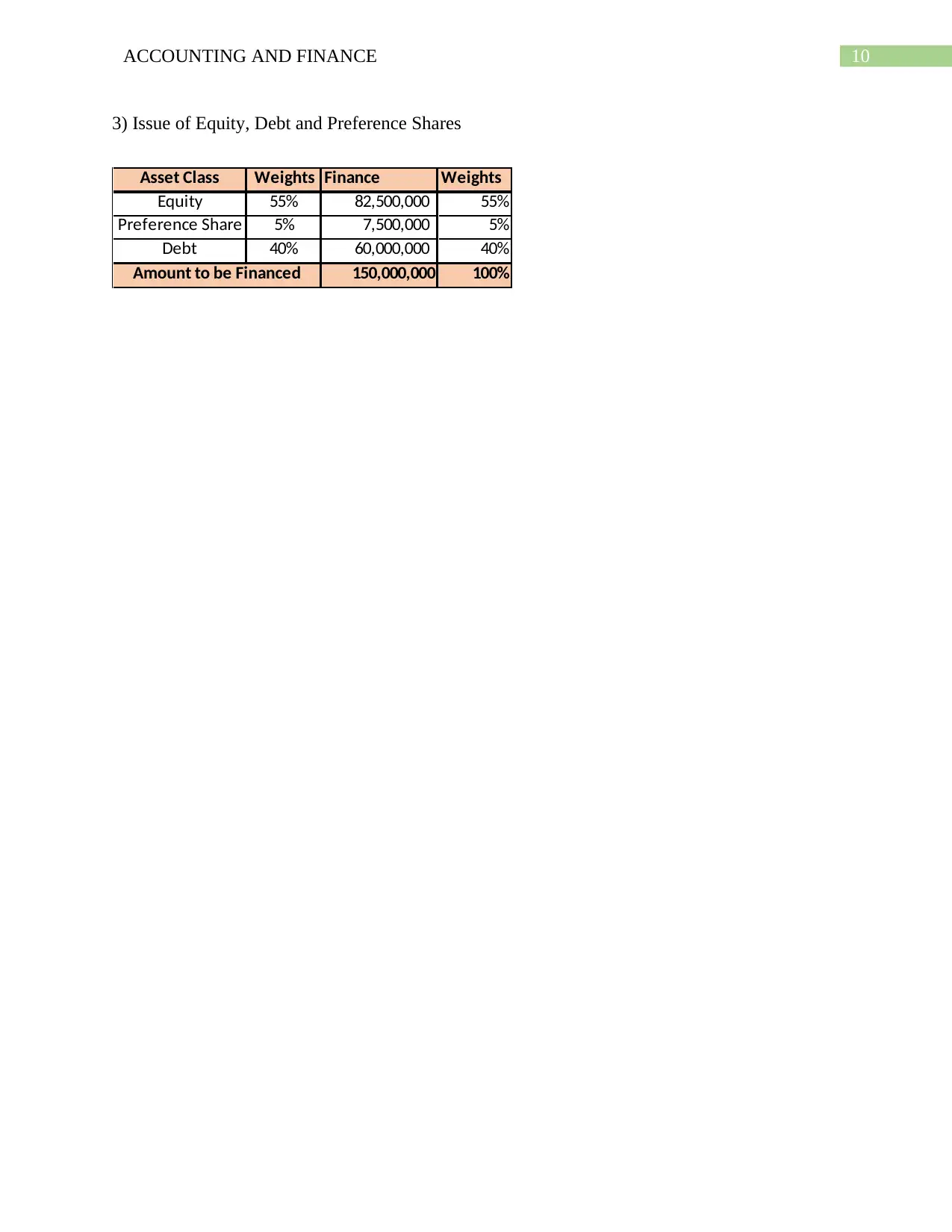
10ACCOUNTING AND FINANCE
3) Issue of Equity, Debt and Preference Shares
Asset Class Weights Finance Weights
Equity 55% 82,500,000 55%
Preference Share 5% 7,500,000 5%
Debt 40% 60,000,000 40%
150,000,000 100%Amount to be Financed
3) Issue of Equity, Debt and Preference Shares
Asset Class Weights Finance Weights
Equity 55% 82,500,000 55%
Preference Share 5% 7,500,000 5%
Debt 40% 60,000,000 40%
150,000,000 100%Amount to be Financed
1 out of 11
Related Documents
Your All-in-One AI-Powered Toolkit for Academic Success.
+13062052269
info@desklib.com
Available 24*7 on WhatsApp / Email
![[object Object]](/_next/static/media/star-bottom.7253800d.svg)
Unlock your academic potential
© 2024 | Zucol Services PVT LTD | All rights reserved.





